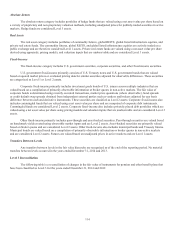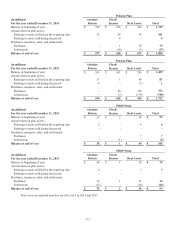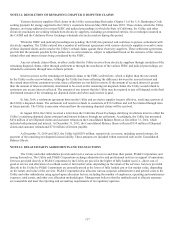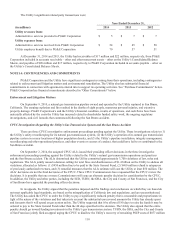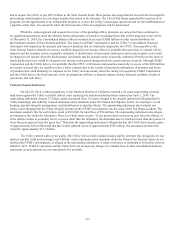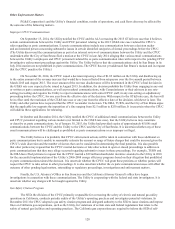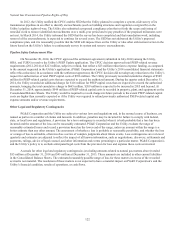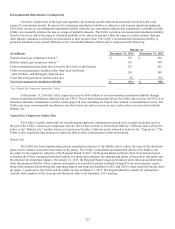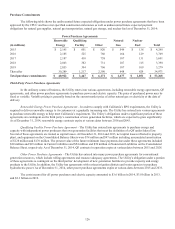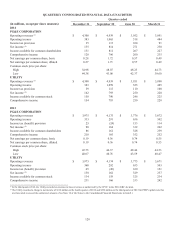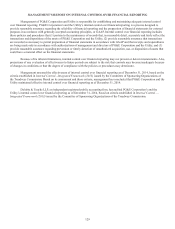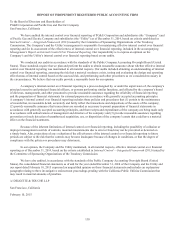PG&E 2014 Annual Report Download - page 129
Download and view the complete annual report
Please find page 129 of the 2014 PG&E annual report below. You can navigate through the pages in the report by either clicking on the pages listed below, or by using the keyword search tool below to find specific information within the annual report.121
identified or self-corrected violations. The SED can consider various factors in determining whether to impose fines and the
amount of fines, including the severity of the safety risk associated with each violation, the number and duration of the violations,
whether the violation was self-reported, and whether corrective actions were taken.
Since the gas safety program became effective, the Utility has filed approximately 84 self-reports and the SED has
imposed fines ranging from $50,000 to $16.8 million (including the $10.85 million fine related to an explosion in Carmel,
California that is discussed below) for violations identified through self-reports, SED investigations and audits. The SED recently
has stated that it will not conduct further investigations into 65 self-reports the Utility had filed through December 31, 2014. The
Utility believes it is probable that the SED will impose fines or take other enforcement action with respect to some of the Utility’s
remaining self-reports or other self-reports that the Utility has filed since January 1, 2015. The Utility believes it is reasonably
possible that the SED will impose fines on the Utility based on allegations of noncompliance that are contained in some of the
SED’s audits. The Utility is unable to reasonably estimate the amount or range of future charges that could be incurred for fines
imposed by the SED given the wide discretion the SED has in determining whether to bring enforcement action and the number of
factors that can be considered in determining the amount of fines.
Carmel Incident
On March 3, 2014, a vacant house in Carmel, California was severely damaged due to a natural gas explosion while
the Utility’s employees were performing work to upgrade the main natural gas distribution pipeline in the area. There were no
injuries or fatalities. The SED conducted an investigation of the incident and alleged that the Utility committed two violations of
certain natural gas safety regulations by failing to follow procedures to update records, to provide its welding crew with accurate
information, and to take steps to make safe any actual or potential hazard to life or property. On November 20, 2014, the SED
issued a citation to the Utility that included a fine of $10.85 million for these alleged violations. The Utility recorded this amount
as an expense for 2014. The Utility has appealed the citation to the CPUC. The SED has requested that the CPUC dismiss the
Utility’s appeal as untimely. The CPUC has not yet addressed the SED’s request. In addition, the Utility was informed that the U.S.
Attorney’s Office was investigating the Carmel incident. It is uncertain whether any charges will be brought against the Utility.
CPUC Investigation Regarding Natural Gas Distribution Facilities Record-Keeping
On November 20, 2014, the CPUC issued an order instituting a new investigation into whether the Utility violated
applicable laws pertaining to record-keeping practices for its natural gas distribution service and facilities. The order also requires
the Utility to show cause why (1) the CPUC should not find that the Utility violated provisions of the California Public Utilities
Code, CPUC general orders or decisions, other rules, or requirements, and/or engaged in unreasonable and/or imprudent practices
related to these matters, and (2) the CPUC should not impose penalties, and/or any other forms of relief, if any violations are
found.
In particular, the order cites the SED’s investigative reports alleging that the Utility violated rules regarding safety
record-keeping in connection with six natural gas distribution incidents, including the natural gas explosion that occurred in
Carmel, California on March 3, 2014. (See “Carmel Incident” above.) On December 22, 2014, as directed by the CPUC, the Utility
submitted a report that explained why the Utility believes the SED’s investigative findings do not constitute violations of law and
also outlined the various programs, measures and actions the Utility has undertaken to continuously improve its distribution record
keeping practices.
PG&E Corporation and the Utility believe it is reasonably possible that the CPUC will impose fines on the Utility or take
other enforcement action in connection with this matter, but are unable to reasonably estimate the amount or range of future loss
contingencies.





